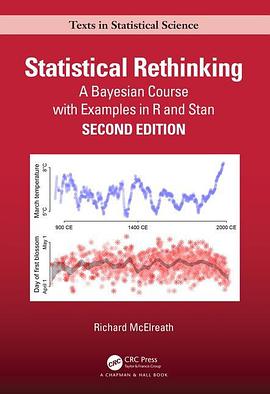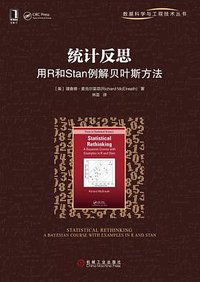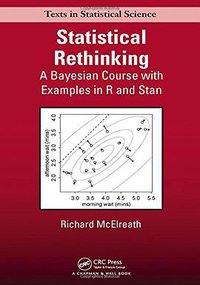Statistical Rethinking (Second Edition)
Douban
A Bayesian Course with Examples in R and STAN
Richard McElreath
Übersicht
The very popular Statistical Rethinking: A Bayesian Course with Examples in R and Stan, Second Edition builds readers’ knowledge of and confidence in statistical modeling. Reflecting the need for even minor programming in today’s model-based statistics, the book pushes readers to perform step-by-step calculations that are usually automated. This unique computational approach ensures that readers understand enough of the details to make reasonable choices and interpretations in their own modeling work.
The main changes in the second edition are:
- Map2stan has been replaced by ulam. The new ulam is also much more flexible, mainly because it does not make any assumptions about GLM structure and allows explicit variable types within the formula list.
- Most modeling examples have some prior predictive simulation. This is the most useful addition to the second edition as it helps understanding not only priors but the model itself.
- Chapter 5 on multiple regression has been split into two chapters. The first chapter focuses on helpful aspects of regression. The second focuses on ways that it can mislead.
- Chapter 4 now ends with B-splines. The chapter on count models, Chapter 11, now includes an item-response (factor analytic) example. Chapter 12 contains a survival analysis with censoring. Chapter 14 has an example of a phylogenetic distance regression. The new Chapter 16 focuses on models that are not easily conceived of as GLMMs.
- There are new data examples such as the Japanese cherry blossoms historical time series and a larger primate evolution data set with 300 species and a matching phylogeny.
- There are several places where raw Stan model code is explained inside optional boxes. This makes the transition to working directly in Stan easier but the main text remains R script using the rethinking package’s teaching tools.
contents
Preface to the Second Edition
Preface
Audience
Teaching strategy
How to use this book
Installing the rethinking R package
Acknowledgments
Chapter 1. The Golem of Prague
Statistical golems
Statistical rethinking
Tools for golem engineering
Summary
Chapter 2. Small Worlds and Large Worlds
The garden of forking data
Building a model
Components of the model
Making the model go
Summary
Practice
Chapter 3. Sampling the Imaginary
Sampling from a grid-appromate posterior
Sampling to summarize
Sampling to simulate prediction
Summary
Practice
Chapter 4. Geocentric Models
Why normal distributions are normal
A language for describing models
Gaussian model of height
Linear prediction
Curves from lines
Summary
Practice
Chapter 5. The Many Variables & The Spurious Waffles
Spurious association
Masked relationship
Categorical variables
Summary
Practice
Chapter 6. The Haunted DAG & The Causal Terror
Multicollinearity
Post-treatment bias
Collider bias
Confronting confounding
Summary
Practice
Chapter 7. Ulysses’ Compass
The problem with parameters
Entropy and accuracy
Golem Taming: Regularization
Predicting predictive accuracy
Model comparison
Summary
Practice
Chapter 8. Conditional Manatees
Building an interaction
Symmetry of interactions
Continuous interactions
Summary
Practice
Chapter 9. Markov Chain Monte Carlo
Good King Markov and His island kingdom
Metropolis Algorithms
Hamiltonian Monte Carlo
Easy HMC: ulam
Care and feeding of your Markov chain
Summary
Practice
Chapter 10. Big Entropy and the Generalized Linear Model
Mamum entropy
Generalized linear models
Mamum entropy priors
Summary
Chapter 11. God Spiked the Integers
Binomial regression
Poisson regression
Multinomial and categorical models
Summary
Practice
Chapter 12. Monsters and Mixtures
Over-dispersed counts
Zero-inflated outcomes
Ordered categorical outcomes
Ordered categorical predictors
Summary
Practice
Chapter 13. Models With Memory
Example: Multilevel tadpoles
Varying effects and the underfitting/overfitting trade-off
More than one type of cluster
Divergent transitions and non-centered priors
Multilevel posterior predictions
Summary
Practice
Chapter 14. Adventures in Covariance
Varying slopes by construction
Advanced varying slopes
Instruments and causal designs
Social relations as correlated varying effects
Continuous categories and the Gaussian process
Summary
Practice
Chapter 15. Missing Data and Other Opportunities
Measurement error
Missing data
Categorical errors and discrete absences
Summary
Practice
Chapter 16. Generalized Linear Madness
Geometric people
Hidden minds and observed behavior
Ordinary differential nut cracking
Population dynamics
Summary
Practice
Chapter 17. Horoscopes
Endnotes

